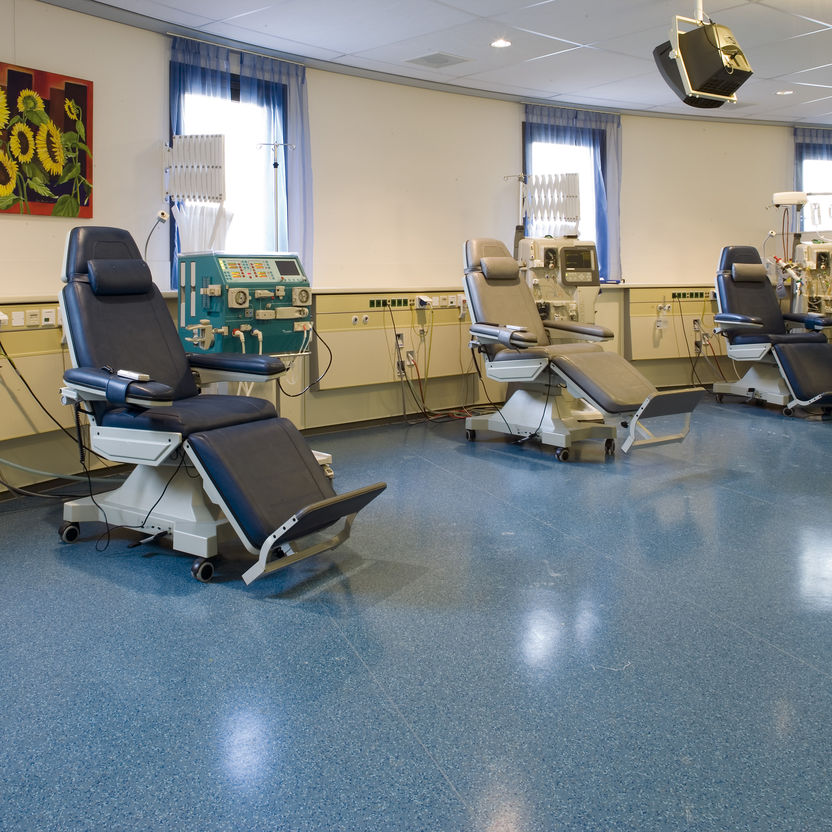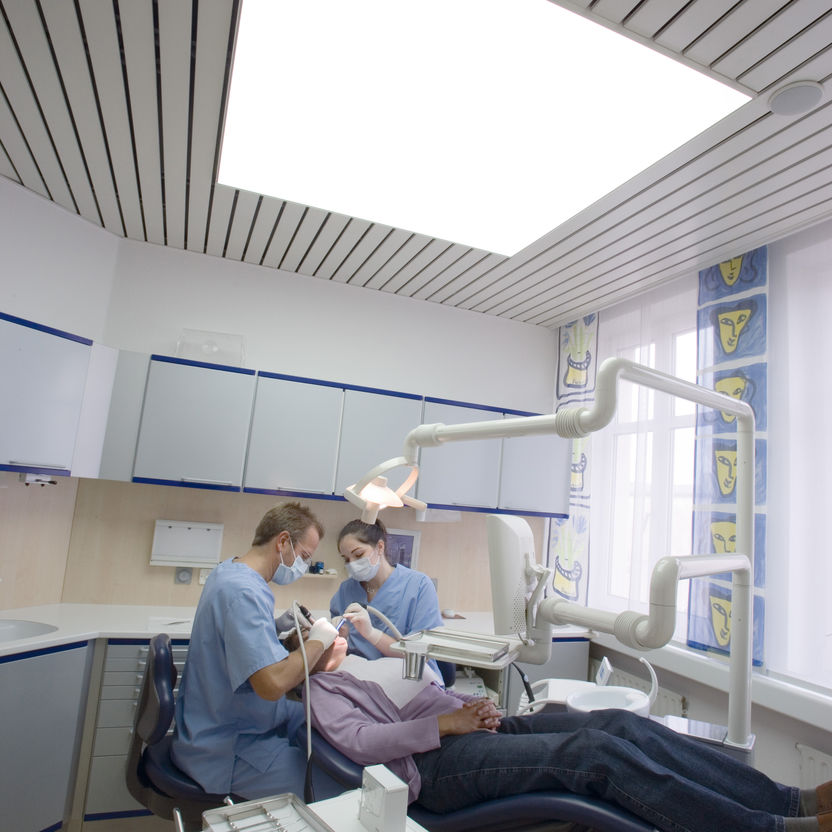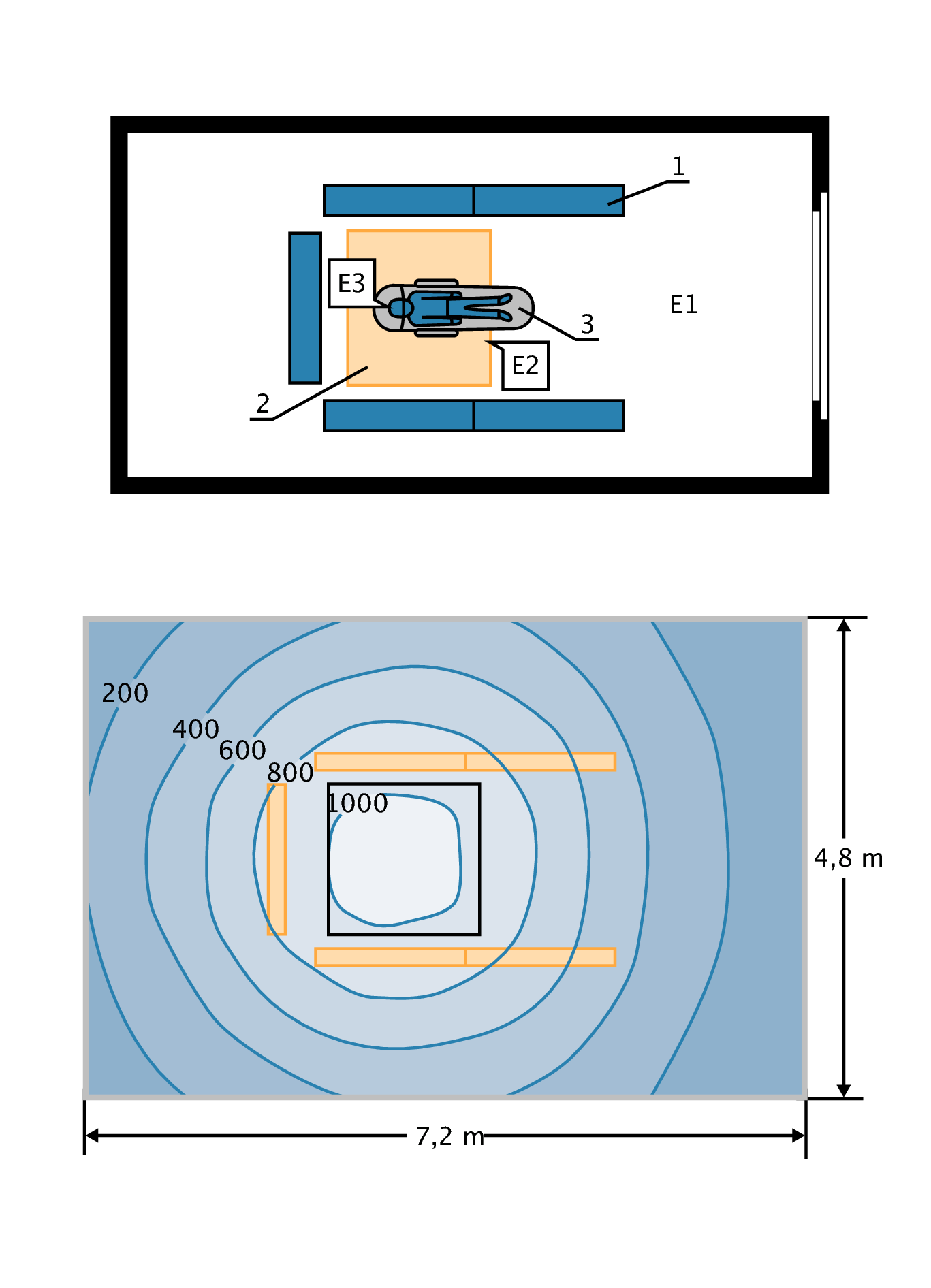The lighting of general examination and treatment rooms should meet the requirements of the physician, but also be as pleasant as possible for the patient. It consist of general lighting and additional lighting for the examination and treatment area. The light colour of general lighting and examination/operating luminaires should be identical as far as possible.
Examination rooms
Regarding photometric and electrotechnical characteristics of portable examination luminaires, EN 60601-2-41 "Medical electrical equipment – Part 2-41: Particular requirements for basic safety and essential performance of surgical luminaires and luminaires for diagnosis" applies. Their colour rendering should be at least Ra = 85, with a colour temperature between 3.000 K and 6.700 K.
The general lighting colour for examination and treatment rooms should be neutral white with a colour temperature between 3.800 K and 5.300 K. For screen work, e.g. entering patient data i.e. for viewing screens e.g. in ultrasound diagnostics, additional requirements apply, see chapter "Lighting of offices and rooms with VDU workstations".
For special examination and treatment rooms as well as emergency care, very different lighting requirements must be observed depending on type and required adaptation level of the examination and treatment in question – both in terms of lighting level and light colour. Illuminance values for adjoining areas or rooms must not vary by more than the factor 10. Otherwise, additional adaptation areas with corresponding illuminance must be provided to create an appropriate adaptation time for the persons switching between the areas.
This applies e.g. for ophthalmological examination and treatment rooms, where, besides general ophthalmological examinations such as examinations of the external eye or eyesight tests, only very low illuminance levels are permissible depending on the type of examination. Examples for such cases are skiascopies (determination of the far point), refractometries (determination of the refractive index), ophthalmoscopies (examination of the fundus of the eye), ophthalometries (pressure measurement in the retinal vessels), perimetries (determination of the extent of the peripheral visual field) and adaptometries (measurement of the visual threshold). In all cases where the lighting level must be adapted to the visual tasks (adjustable), this can be implemented via switching, controlling, regulation or a combination thereof.
ENT (ear, nose and throat specialist) examination rooms require general lighting as well as special lighting at the examination station (also for the Helmholtz ophthalmoscope).
Diagnostic imaging methods pose additional requirements for lighting in examination rooms and operating theatres, particularly regarding lighting levels as well as glare limitation. Examples for imaging methods:
Sonography visualises tissue without ionising radiation.
Digital subtraction angiography (DSA) makes stenoses (constrictions) in blood vessels clearly visible.
Endoscopies (minimally invasive surgery) reduce surgical risk.
Computer tomography and nuclear spin (magnetic resonance) tomography provide precise insight into the body.
The level of general lighting follows the method of examination and treatment for imaging diagnostics and treatment rooms (e.g. X-ray or ultrasound diagnostics). Where X-ray radiography is the only method used, there are no particular requirements for lighting. Where images are displayed on VDU devices, it is possible to facilitate a reduction in general lighting illuminance to lower values. Reflected glare on screens must be avoided. In special cases such as minimally invasive surgery, particular light colours are used (see section Minimally invasive surgery). The lighting level can be adjusted to the visual tasks by means of switching, controlling, regulating or a combination thereof.
General information on VDU-compliant lighting can be found in chapter "Lighting of offices and rooms with VDU workstations".
Due to the possibility of prolonged stays, it may be necessary to temporarily reduce illuminance in delivery rooms to a level perceived as comfortable. Special examination and treatment luminaires supplement general lighting. Beyond that, particularly in cases of longer times of preparation and stay, accent room lighting, e.g. spotlighting on walls, paintings or other accents can be very helpful for the psychological condition of the patient.
Lighting in dialysis rooms is intended to facilitate medically required visual tasks for access and removal (meaning cannulating and removing cannulas for extracorporeal blood flow) in dialysis treatment (blood purification), which requires high levels of illuminance. For treatments with visual requirements exceeding the aforementioned, special examination lighting must be provided. During ongoing dialysis treatment, the room should be equipped with comfortable general lighting and reading lighting at each station, as in general wards. The recommended light colour is warm white.
One of the essential visual tasks in dermatology examination and treatment rooms is precise diagnosis of changes in skin colour. Therefore, daylight white or neutral white light colours with excellent colour rendering (Ra ≥ 90) are recommended.
Preparing endoscopic examinations requires elevated illuminance levels. During the actual endoscopic examination, the usually lower luminance in the optical endoscope system requires a reduction in room illuminance. This applies for direct as well as monitor-supported endoscopies. The lighting level can be adjusted to the visual tasks by means of switching, controlling, regulating or a combination thereof.
Therapy rooms are rooms where patients are treated with physical, radiological or electromedical methods. This includes rooms for physiotherapy, massages and medical wraps or baths. In addition to general lighting, accent lighting and room colour design can significantly contribute to relaxation and treatment success. According to the type of therapy, individual lighting level and light colour adjustment can be beneficial.
The general lighting in dental examination and treatment rooms must comply with the optical requirements for treatment luminaires according to EN ISO 9680 "Dentistry – Operating lights" (2007 edition). The maintained illuminance for lighting the traffic and preparation areas of treatment room E1 and patient area E2 (figure) applies to a horizontal assessment plane at 0,85 m above the floor. The lighting of the patient area E2 is rated in a horizontal plane of 1,5 m · 1,5 m surrounding the actual treatment field (E3 being the patient’s mouth). The light colour of the light source used must be daylight white with a colour rendering index Ra ≥ 90 (see also figure). It is recommended to reduce luminance in luminaires above the patient area to a maximum of 1.000 cd/m² to avoid direct glare for patients who are usually reclining. Where this is not possible, luminaires should be arranged outside the patient area E2 (figure). An additional indirect lighting component increases background luminance on the ceiling from the patient’s perspective and thus reduces direct glare. Individual lighting level adjustment may be necessary when using imaging methods.
For general lighting in zone E1, a U-shaped ceiling luminaire arrangement outside of zone E2 which reaches its peak illuminance in the patient’s head area has proven practical due to reduced glare (figure). Increased patient comfort is achieved by using light ceilings which cover zone E2 entirely or in part. During waiting periods (e.g. while analgesics take effect), light ceilings can have a calming effect on patients if their luminance is reduced (dimmed) or their light colour is slowly lowered towards warm white (e.g. down to below 3.000 K), e.g. using a suitable control system. During treatment, it is possible to set the maximum permissible luminance of 10.000 cd/m² as well as the required light colour of 6.500 K (see figure b).

(a) Dialysis room

(b) Dental treatment room
Figure 3.121: Treatment rooms

Figure 3.122: Zones E1, E2, E3 and example for a luminaire arrangement in dental examination and treatment rooms (above), 1: luminaires, 2: patient area, 3: treatment chair. Isolux curves (values in lx) as the result of photometric design (below). Alternatively, it is possible to use a light ceiling (see figure, right). Comment 1: Photometric design with 5 luminaires 2 x 49 W/T5, Ra ≥ 90 Comment 2: The photometric parameters for the light ceiling can be adjusted over wide ranges: Comfort lighting: 300 lx, 2.700 K; work lighting: 2.800 lx, 6.500 K, max. luminance 4.000 cd/m²